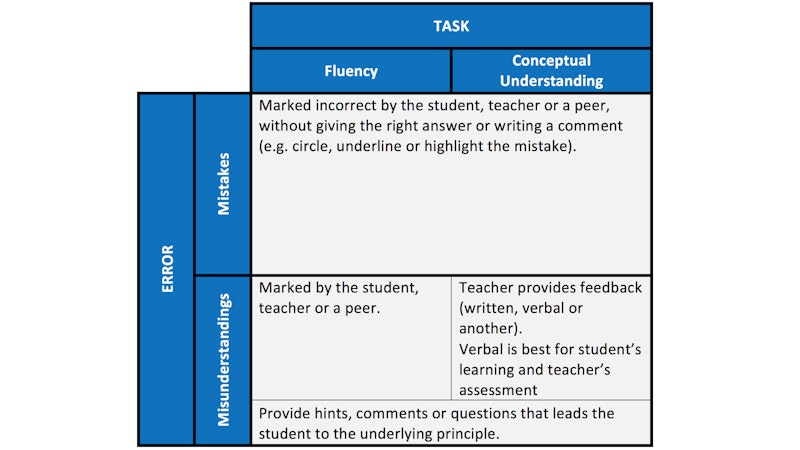Teaching activity
Effective Marking and Feedback in Mathematics
28th November 2016
It’s not ground-breaking to say that effective marking and feedback leads to improved quality of student work, and to students improving their mathematical understanding. But what is “effective” and how can we work smart when undertaking what can be such a time-consuming element of teaching?
We summarise the key guidance and advice from the NCETM and OFSTED ( 1NCETM Secondary Marking Guidance - October 2016, 2NCETM Director’s Blog - October 2016, 3Ofsted inspections: myths - August 2016) on marking and feedback in Maths.
First and foremost, for marking and feedback to have the maximum positive effect on students’ learning, the official guidance is clear that the form in which it takes must be appropriate to the task being assessed and the students’ response to that task. In other words, there is no ‘one size fits all’ model1.
Significant consideration should also be given to what it’s real purpose is. For teachers, this is:
- To know whether students understand what they have learnt.
- To inform future lesson planning.
- To diagnose students’ learning difficulties and provide feedback.
And for students?...
- To know whether an answer or solution is correct.
- To receive praise and reassurance when they are correct.
- To know how to correct errors and learn from these.
All these points are important and of course go hand-in-hand. Students may know how to correct errors, but if they haven’t received sufficient reassurance of their understanding then they may lack the confidence to respond correctly to future questions. Equally, as teachers we can only plan lessons effectively if we are sure that our students understand what they have learnt.
This is a good moment to also point out that one thing marking should not be is an act of demonstrating that you are doing your job! If you mark for the sake of it, that’s not an effective use of your time.
So, what do we mark, when do we mark it, and how do we do this effectively so that our students get the feedback they need, and we can focus equal (if not more) attention on lesson planning instead of marking?
There are a few handy points raised in the NCETM and OFSTED guidance:
- Marking should primarily be verbal, although written feedback may be useful when this is most effective in supporting the student to make progress.
- It is important to differentiate between students’ mistakes and misunderstandings. The first are due to carelessness or failing to apply a routine method correctly, whilst the latter are due to incorrect reasoning, or applying a concept incorrectly. Identifying the difference is important as they require two different marking styles. In the box below, I’ve provided two examples to make the distinction clear:

For the purpose of marking and feedback (of both classwork and homework), we can consider tasks to be one of two types:
- Tasks assessing fluency (i.e. accuracy, efficiency of method, or procedural competency); and,
- Tasks assessing conceptual understanding (including problem solving or reasoning).

This applies to both classwork and homework, however most feedback for classwork should be verbal so that students can respond immediately. Note that there is no requirement to make any form of written record of feedback given verbally. Also, where the same error is repeated by several students, this should be addressed in lesson time, not as written comments. Finally, students need time to reflect on feedback, and this should be explicitly planned for during lessons, with opportunity for one-to-one and/or class discussion.
So, to briefly summarise….
- When marking, never lose sight of your intent or purpose. Are you building feedback into your future lesson planning, providing reassurance to your students and developing their understanding (as opposed to going through the motions to prove you are doing your job)?
- For marking and feedback to be effective, it is important that it is timely. As such, verbal feedback is often better.
- And finally, always keep in mind two distinctions: whether you’re correcting a mistake or a misunderstanding, and whether you’re assessing fluency or conceptual understanding. These are important because they require different marking approaches.
Successfully taking on board these points should in turn lead to “students’ sustained improvement in mathematical reasoning and understanding”1, and the quality of their work should improve.
The opinions expressed in this article are entirely those of the author.
References
You might also like
Free Giant Classroom Posters to Help with GCSE 9-1 This Summer!
19th January 2017
Interesting data for 2016 fom the Office of National Statistics
27th February 2017
Maths GCSE Exam Questions
27th April 2017
GCSE Maths Higher Revision Workbook
12th May 2017
Revision Quizzes to Help Prepare for Paper 2 and Paper 3
25th May 2017
tutor2u Maths Questionnaire
13th July 2017